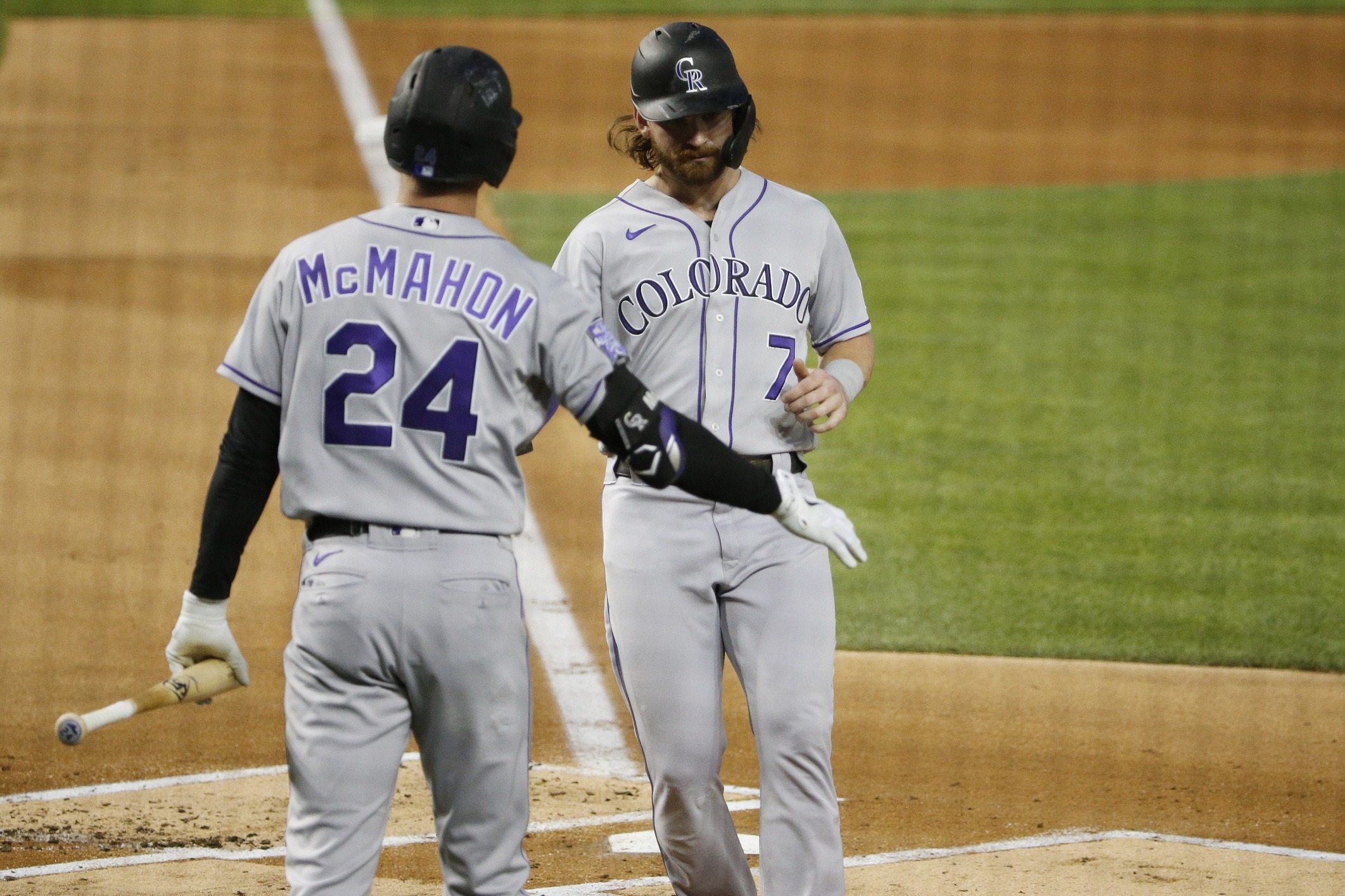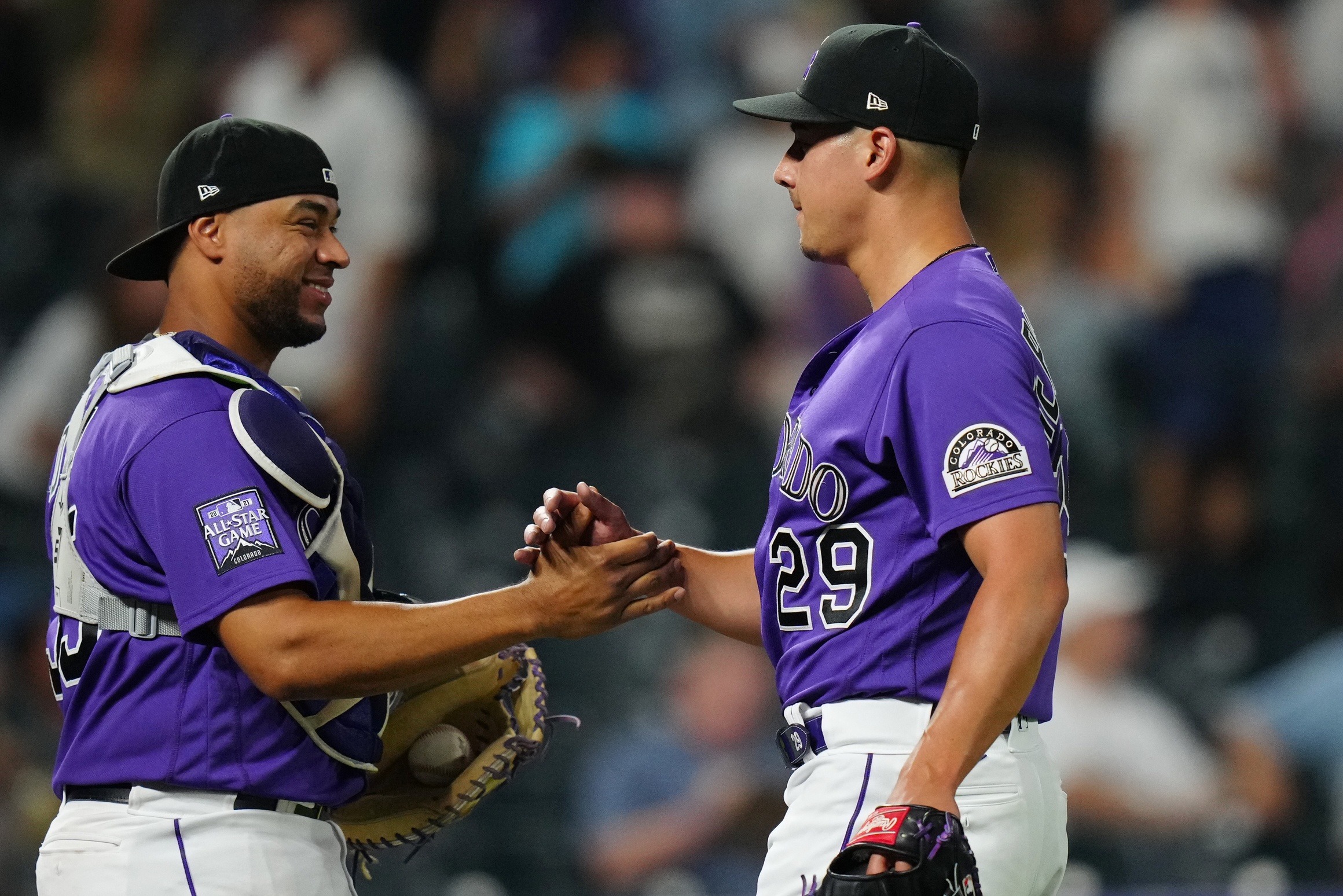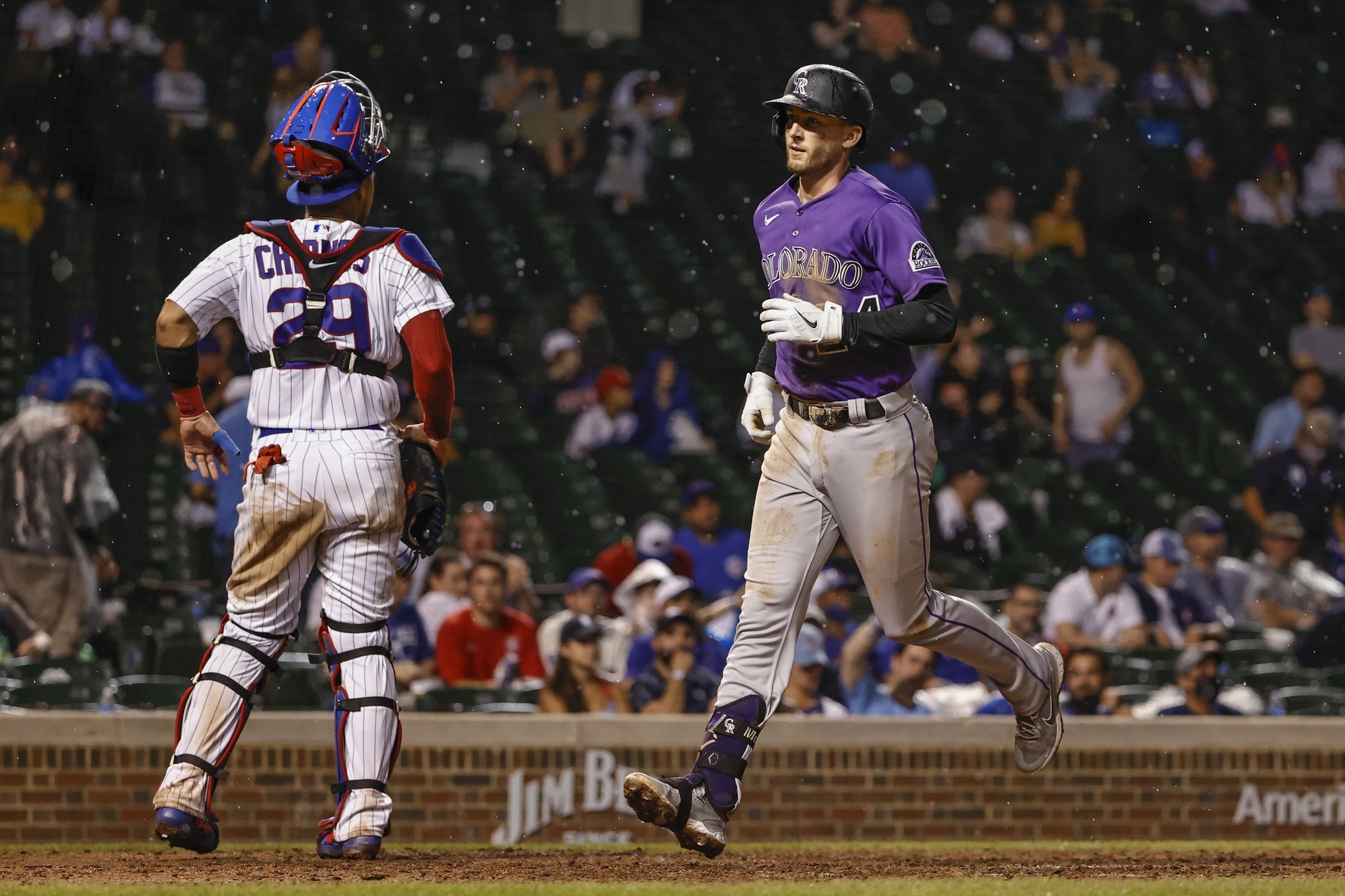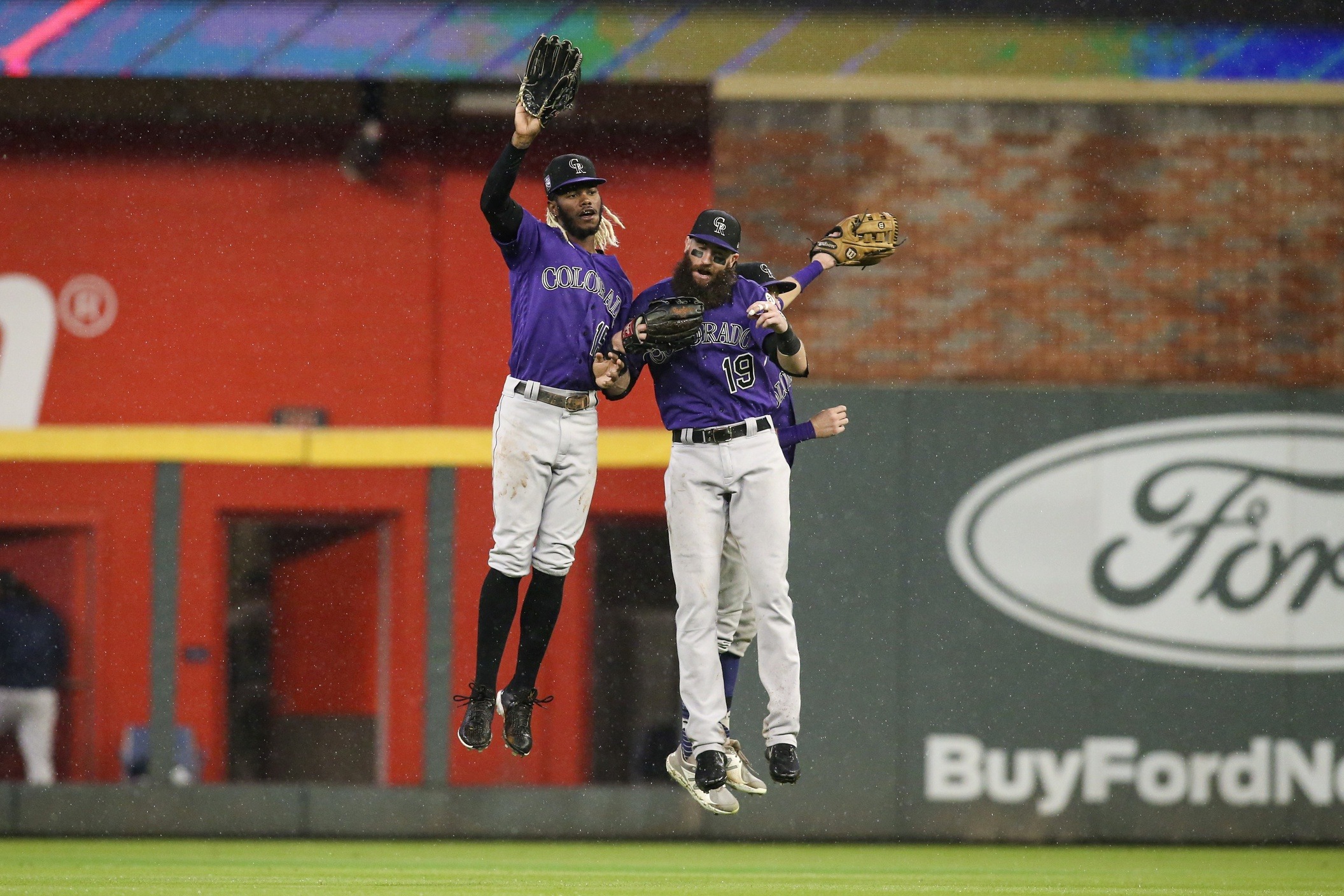© 2025 ALLCITY Network Inc.
All rights reserved.

Since May 21, the Colorado Rockies are 55-51.
Because of the screwed up economics of baseball, trying to lose is a viable strategy for at least third of the teams in MLB so it makes perfect sense that some would see this not as success but rather as a failure of another kind.
After all, they aren’t making the postseason so other than giving Rockies fans a more pleasant day-to-day baseball watching experience, what are they accomplishing other than worsening their draft position?
Can you even enjoy these wins?
Well… yeah.
It would be one thing if veterans like Charlie Blackmon and Trevor Story were powering this surge over the last 105 games. Story may well be gone soon and Blackmon, while always a key piece for this team, looks like he has aged past the days of being a true star player in MLB.
According to the league-and-park-adjusted OPS+, both have been decidedly mediocre this season with Blackmon at 94 and Story at 103, well below their career marks.
Better performance from these two leading to wins would have been fun to watch but meant little to the future.
Similarly, if the starting rotation (clearly and always the best part of this roster) had gone Super Saiyan in the last few months, it would have been a lot of fun but largely unimportant.
We know what German Marquez, Jon Gray, Kyle Freeland, and Antonio Senzatela can do at this point and so its fine that they’ve been steady. In fact, Marquez, the team’s only All-Star, has been more in a slump lately than any of them.
If anything, the rotation has slowed down as a collective as the season has gone on.
So why are the Rockies winning more games? In short, because potentially key components of the future have grown, some exponentially, throughout the course of the season.
No one has had a bigger turnaround than catcher Elias Diaz who went from being one of the worst hitters in baseball in April and May to one of the best hitting catchers in baseball this season.
Brendan Rodgers began the year as a giant question mark and will end it looking like a player set to break out in a big way in the very near future. He also emerged as a capable road hitter which may end up being the biggest development of the season.

Ryan McMahon still hasn’t become a star hitter but he has become a superstar defender at multiple positions allowing for invaluable flexibility to get necessary experience for guys like Rodgers and Garrett Hampson. It also allows the team to be creative with how they choose to spend their wide open budget this offseason.
Raimel Tapia has shown that he can be exactly what he has always been at the plate but now at the MLB level and for a 162-game season. He also dramatically improved on the bases and in the field.
Prospect Colton Welker has already gotten in on the action by delivering some clutch at-bats in some big road wins.
Oh, and Connor Joe happened.
We don’t know yet if C.J. Cron holds any future value for the Rockies but you can rest assured that if the two parties do come to an agreement, his Player of the Month performance in August will go a long way toward making that happen.
The bullpen, still very much in need of an overhaul, has still nonetheless been leaps better than they were in the first few months.

Carlos Estevez gets your heart rate up but has shown a knack for the strikeout pitch and securing the final three outs.
Jordan Sheffield (188 ERA, 24.1 IP) and Robert Stephenson (136 ERA+ in 40.1 IP) lead the way in the advanced and peripheral stats, showcasing some raw talent and ability that may see them battling it out for a future closer role.
Lefty Lucas Gilbreath has arguably been the biggest revelation here with a strong 129 ERA+ in 36 innings of work.
Even the veteran pickup Jhoulys Chacin looks like he has found his home (again) with the Rockies and should be a cheap and good addition to the roster in the likely event they choose to bring him back next season.
Tyler Kinley has quietly worked his way into a positive season as well with a 102 ERA+ in 64 innings of work.
That means that all of a sudden the Rockies ‘pen has only three guys putting up below-league-average numbers: Daniel Bard (91) Ben Bowden (74) and Yency Almonte (59).
And they can afford to bring them all back for next to nothing in terms of big league dollars leaving plenty of room to add more reliable late-inning arms.
So let’s ask the question again. Why are the Rockies winning more now than they were earlier in the season?
Because position players and relievers who will be a part of their future have gotten significantly better. Whether they’ve gotten sustainably better remains to be seen but that’s why they play the games.
If you want the Rockies to employ the strategy of being bad for several years before trying to be good, this is bad news.
If you want the team to try to compete next season and the season after, this is great news.
It makes the Rockies needs going into the offseason incredibly clear. You’ve got a baseline of belief in your infield and rotation, so go get outfielders and relievers. That’s helpful information to have learned for a team intent on doing just that.
It’s difficult if not impossible to quantify the value of what the Rockies have gained so let’s look at the other side of it for a moment. What have the Rockies lost?
Draft position.
As it stands now, the Rockies would get the 10th pick in the draft next summer. If they finish well, they could pass as many as four teams in the standings (Cleveland, Detroit, LAA, and NYM) and end up with the 15th pick.
Losing more these last few weeks could seem them “catch” as many as four teams (Royals, Cubs, Twins, Marlins) in the reverse standings and wind up with the sixth pick.
If Colorado had maintained their worst stretch of the season, a 15-29 start that had them at a .340 winning percentage, they’d be in line for the third pick as both the Baltimore Orioles and Arizona Diamondbacks at .320 have been even worse than that.
Let’s put a number on it. How much future value have they lost by winning?
Fangraphs in 2019 put together a report on the value of a draft pick, not slot value for signing a potential player, but the theoretical value of having the pick itself at your general disposal. Draft picks are more valuable than slot money because young players make less than veterans and are more likely to outperform their contracts.
Understanding that these numbers have increased over the years and that they are approximations, Fangraphs has the 10th pick in the draft valued at $22.3 million.
The third overall pick is valued at $38.2 million and the fourth at $34.8 million. Fair to say that’s a significant difference in value.
But, of course, there is no guarantee, especially in this year and climate, that remaining bad would have meant they could “compete” with Texas and Pittsburgh both of whom are set to lose 100 game or more, something the Rockies have never done in their franchise history.
What if they had gone all in on selling at the trade deadline?
Like the Washington Nationals or Chicago Cubs?
The Nats sit comfortably with the fifth pick, unlikely to tank hard enough to catch the top four or win enough to fall out of the Top 5. That pick, a potentially achievable one with the proper tanking strategy, is worth $31.9 million, or $8.6 million more than the Rockies at 10th.
The Cubs currently hold the 8th pick, worth $25.9 million, only $2.6 million ahead of Colorado’s current position.

Just like there is no guarantee you will be the best team just for trying to be the best team, there is no guarantee that you will be the worst team by trying to be the worst. Especially with all this “competition.”
If the boys in purple do go on a run and end up near .500 and with the 15th pick in the draft? They will then have something that is worth $18.4 million in value, $4.9 million less than what they have right now.
The question we have to ask ourselves is how high of a draft pick could the Rockies reasonably have achieved and is the difference in value between that and what they will end up with greater or lesser value than the value of what has been gained in the last few months?
What has been gained in the last few months?
A catcher of the future.
Two MLB caliber infielders who still boast star potential.
Much more reliability in the bullpen.
Near certainty about the quality and future of the starting rotation.
A clear roadmap for improvement.
Growing confidence and team chemistry for a club that still has massive potential for internal improvement.
Sure, there are teams like the Astros and Cubs over the last decade who showed that you can use the “losing on purpose” strategy to great effect, especially if you have the resources to buy elite pitching to glue it all together at the end.
Some teams rebuild well but some just build a culture of losing.
The Pirates, Marlins, Orioles, and Tigers have all had their fair share of top draft picks over the years and long-term plans that never quite found their way into winning in the short term.
One other thing worth noting is that this entire dynamic is going to be addressed in some way during the upcoming CBA negotiations this offseason.
The league knows that it is not good for the long term health of these fanbases to incentivize losing so heavily and even things like the expansion of the postseason are likely to put a dent in the viability of this strategy moving forward.
Almost anyone who advocates tanking in baseball will also tell you that it isn’t a one-year experiment but a multi-year plan that must be executed and committed to.
Keeping all that in mind, how much damage have the Colorado Rockies done to their future by being suddenly competitive over the last 106 games?
Not much.
If they could have had the third overall pick and end up with the 15th? Yeah that’s a pretty dramatic drop-off in theoretical lost value. About $20 million.
The more likely scenario though is that even by selling off some pieces they’d still have ended up in a decent position. Again, look back to the reasons why they are winning.
Realistically, we’re talking about the difference between the 6th pick at best and the 12th pick at worst. About $8 million. If they hold steady at 10th, they’ve cost themselves a grand total of $6 million in theoretical value.
And that’s the totality of the downside to winning. Y’know, the point of sports.
Of course, we also have to remember that those Fangraphs values, while incredibly helpful, become largely irrelevant once the pick becomes an actual person.
Any baseball fan can recount a myriad of stories about top picks who flamed out and players taken well after the 20th round who ended up in the Hall of Fame.

There is a school of thought that had the season turned into an absolute and total disaster, it would have ushered in an era of change in Colorado.
The alternate universe where the Rockies lose 103 games this season, Dick Monfort “sees the light” dramatically increases the analytics budget, hires an entirely new front office from outside the organization, and completely re-thinks the way things are done around here… seems more far-fetched to me than most of the Marvel “What If…” scenarios.
Oddly enough, it also places quite a bit of faith in Monfort’s capacity to suddenly change, something he isn’t exactly known for.
There’s also the thought that this run will lead to the team sitting on their hands in the offseason and making zero changes which doesn’t track with anything interim GM Bill Schmidt has said about the team’s plans to be aggressive in the offseason.
It also doesn’t track with the Rockies history of being in the top half (and usually in the top third) when it comes to payroll and that they have practically nothing on the books for next season.
All that will play out, though.
For right now in this moment, by playing better and winning baseball games, the Rockies haven’t just abided by the integrity of competition, they’ve re-centered a core they can build around for the future and clearly highlighted where they need to get better.
It’s hard to say exactly what that’s worth, but to me it’s worth more than the difference between the 6th and 10th pick in the most unpredictable draft in professional sports.
Comments
Share your thoughts
Join the conversation



